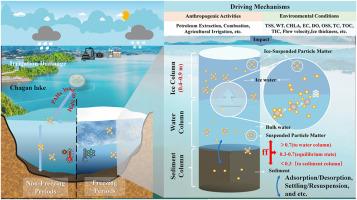冰冻湖泊中多环芳烃的冬季行为:对分配、运输和关键驱动机制的逸散性见解
IF 7.3
2区 环境科学与生态学
Q1 ENVIRONMENTAL SCIENCES
引用次数: 0
摘要
当湖泊冰融化时,多环芳烃(PAHs)会造成生态风险,这可能会引发春季污染的急剧增加。然而,关于冬季多环芳烃在寒冷地区湖泊中的行为信息不足。研究了某代表性湖泊冰冻期多环芳烃的分配和迁移。在冰、冰柱中的悬浮颗粒物(SPM)、散装水、水柱中的悬浮颗粒物(SPM)和沉积物五种环境介质中评估了多环芳烃的动态分布。基于2021年野外采集的数据,采用多媒体逸度模型和Spearman相关分析对多环芳烃的命运进行了表征,并确定了关键的影响机制。结果表明:87.00%以上的低环多环芳烃以气溶胶形式滞留在冰柱中,88.00%以上的总多环芳烃以气溶胶形式结合在水柱的SPM中。逸度分数显示垂直迁移方向相反,低环多环芳烃倾向于从沉积物向上迁移到水中,而高环多环芳烃则相反。Spearman相关分析表明,总悬浮物、叶绿素-a和温度是影响多环芳烃在不同介质中分布的关键因素。冰冻期多环芳烃的分布受物化性质、研究区自然条件以及采油、灌溉回灌等人为活动的强烈影响。这些发现强调了修订监测方案的必要性,以解决spm介导的冬季多环芳烃运输问题。本文章由计算机程序翻译,如有差异,请以英文原文为准。

Winter behavior of polycyclic aromatic hydrocarbons in frozen lakes: fugacity insights into partitioning, transport, and key driving mechanisms
Polycyclic aromatic hydrocarbons (PAHs) pose ecological risks when the ice in lakes melts, which may trigger sharp increases in pollution in the spring. Nevertheless, there is insufficient information about the behavior of PAHs in lakes in cold regions during winter. This study investigated the partitioning and transport of PAHs during a freezing period in a representative lake. The dynamic distribution of PAHs was assessed across five environmental media: ice, suspended particulate matter (SPM) in the ice column, bulk water, SPM in the water column, and sediment. Based on field data collected in 2021, a multimedia fugacity model and Spearman correlation analysis were used to characterize the fate of PAHs and identify key influencing mechanisms. The results show that over 87.00% of low-ring PAHs are trapped in the ice column in aerosol form, while more than 88.00% of total PAHs are bound to SPM in the water column. The fugacity fraction revealed opposing vertical migrations in that low-ring PAHs tended to move upward from sediment to water, while high-ring PAHs exhibited the opposite trend. The Spearman correlation analysis indicated that the key driving mechanisms included the total suspended matter, chlorophyll-a, and temperature, which play critical roles in shaping the distribution of PAHs across different media. The distribution of PAHs during the freezing period was strongly influenced by the physicochemical properties, the natural conditions of the study area, and anthropogenic activities such as oil extraction and irrigation return flow. These findings highlight the need for revised monitoring protocols to address SPM-mediated PAH transport in winter.
求助全文
通过发布文献求助,成功后即可免费获取论文全文。
去求助
来源期刊

Environmental Pollution
环境科学-环境科学
CiteScore
16.00
自引率
6.70%
发文量
2082
审稿时长
2.9 months
期刊介绍:
Environmental Pollution is an international peer-reviewed journal that publishes high-quality research papers and review articles covering all aspects of environmental pollution and its impacts on ecosystems and human health.
Subject areas include, but are not limited to:
• Sources and occurrences of pollutants that are clearly defined and measured in environmental compartments, food and food-related items, and human bodies;
• Interlinks between contaminant exposure and biological, ecological, and human health effects, including those of climate change;
• Contaminants of emerging concerns (including but not limited to antibiotic resistant microorganisms or genes, microplastics/nanoplastics, electronic wastes, light, and noise) and/or their biological, ecological, or human health effects;
• Laboratory and field studies on the remediation/mitigation of environmental pollution via new techniques and with clear links to biological, ecological, or human health effects;
• Modeling of pollution processes, patterns, or trends that is of clear environmental and/or human health interest;
• New techniques that measure and examine environmental occurrences, transport, behavior, and effects of pollutants within the environment or the laboratory, provided that they can be clearly used to address problems within regional or global environmental compartments.
 求助内容:
求助内容: 应助结果提醒方式:
应助结果提醒方式:


